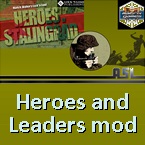asl3d
Posts: 6531
Joined: 2/6/2017
Status: offline

|
StuG IIIF
With the arrival of the longer Stu.K. L/40, penetrating ability of the rounds was improved, and a battery of tests followed. As a result, the total load was reduced to 44, and the round proportions were changed. 12% of the shells were K.Gr.rot. Pz (armor piercing, capped, with tracer and explosive filler), 65% were HE rounds, or Sprenggranaten, and 23% smoke shells, or Nebelgranaten. Eventually, a fourth type was introduced, with increased efficiency against armor, thanks to the shaped charge principle. This was the HEAT or Gr.38 HL round. It was designed for excellent fragmentation performance, but was still very effective against softskin targets. The initial design was less successful than the K.Gr.rot. But, after the introduction of the HL/A & B, the numbers supplied to frontline units steadily grew. As an indication, an Ausf.D was captured in North Africa crammed with 88 rounds, including 20 HL/As and 35 K.Gr.rot., signalling an increase in tank to tank use.
The “long barrel” series, Ausf.F and F8
These series were known by the Waffenamt as the Sd.Kfz.142/1.
-The Ausf.F was an all-out improvement dictated by war experience against Russian tanks and the urgent need for high velocity guns on every platform available. It appeared on the production line in March 1942. The gun was the new 7.5 cm StuK 40 L/43. This 3.3 m long barrel was a real game-changer, with a muzzle velocity of 740 m/s when fed with the armor-piercing Panzergranat-Patrone 39. The Pzgr.Ptr.39 was indeed proven to defeat 99 mm (3.9 in) of sloped armor at point-blank range (100 m), and still 63 mm (2.48 in) at 2000 m. The optimal engagement range was 500 m, due to the lack of a turret, were it could pierce through 91 mm (3.58 in) of armor at a 30° angle slope. This was proven enough to destroy the most common T-34 tanks and saw the role of the StuG shifting from an infantry support vehicle to an ubiquitous tank-hunter. Another change was the exhaust fan added to the rooftop. By June 1942, with the production rate increasing, 30 mm (1.18 in) appliqué armor was bolted to the lower frontal plate, while the gun was upgraded to the StuK 40 L/48. In total, 366 were produced until September 1942.
-The Ausf.F8. This version appeared in September 1942 and 250 vehicles were built up to December. The name was derived from the chassis version of the Panzer III it was based on, the 8th, or Ausf.J/L, which had increased rear armor. The hull was characterized by towing hook holes extended from the side walls. It was armed, from the beginning, with the new 7.5 cm StuK 40 L/48, which could defeat 96 mm (3.78 in) of angled armor at 500 m, and 85 mm (3.35 in) at 1000 m (30° slope). With the same ammunition, the 3.6 m long barrel had better muzzle velocity, reaching 760 m/s for the Pzgr.Ptr.39. After October, 30 mm (1.18 in) of appliqué armor were bolted on to the front during the production run. Some were later retrofitted with side skirt armor.
The long barrel
Krupp already started worked on the s.Pak L/42 from January 1940, and the project evolved until March 1941. It was then shown to Hitler and an optimistic spring 1942 target was set for production. However, Wa Prüef 4 was ordered to cease work on the new gun design as the OKW, after evaluating the reports from losses due to T-34s and KV-1s, realized that not only protection needed to be increased, but the long barrel gun had to have an even greater muzzle velocity. Wa Prüef 4 then used this letter to require Rheinmetall to design a new gun with a 770 m/s muzzle velocity (with HE) and penetration of 80 mm/30° (3.15 in) at 1000 m.
The Sturmgeschutz-Abteilung GrossDeutschland and the LSSAH were the first to receive 22 of the new Ausf.F in operations, built since March-April 1942. At the start of the summer offensive on the Eastern front, there were about 210 Ausf.Fs in operation (18 units). By November 1942, 448 Ausf.F/Gs served with 22 units. By the time Kharkov was retaken in February 1943, GrossDeutschland Division’s StuG units claimed 44 T-34s (whereas the Tigers only destroyed 30). Around Leningrad, the Abteilung 226, with its 41 StuGs (including replacements), claimed an impressive score of 221 T-34s and KV-1s among others, for 13 losses. By March 1943, Abteilung battery composition was changed and increased. By the time the summer offensive started, all 26 units were replenished with new StuG Ausf.Gs, for a total of 727 right before “Zitadelle” took place.

 Attachment (1) Attachment (1)
_____________________________
Semper fidelis
|
 Printable Version
Printable Version



































 New Messages
New Messages No New Messages
No New Messages Hot Topic w/ New Messages
Hot Topic w/ New Messages Hot Topic w/o New Messages
Hot Topic w/o New Messages Locked w/ New Messages
Locked w/ New Messages Locked w/o New Messages
Locked w/o New Messages Post New Thread
Post New Thread